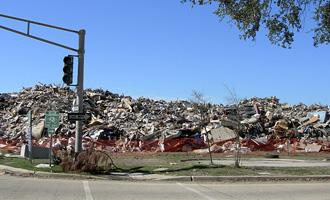Climate Adaptation and Disaster Debris Management
 EPA provides emergency response when requested or when state and local first responder capabilities have been exceeded.
EPA provides emergency response when requested or when state and local first responder capabilities have been exceeded.
Climate change will lead to more frequent and intense storms that may put at risk communities and sites that had not been previously impacted by flooding and storm surge. More powerful storms may also generate large amounts of debris that will need to be appropriately managed. Examples of the types of debris that may be generated include brush and trees, animal carcasses, construction materials, sediment, vehicles, and electronic waste.
Hurricane Katrina and Superstorm Sandy illustrated the importance of having a waste management capacity to handle large amounts of disaster debris. To ensure state, tribal, local, and regional resources are not overwhelmed, clean up efforts require advance planning and coordination among individuals at levels of government and the private sector with expertise in waste management. These resources include land disposal space, equipment for transporting debris, and emergency response personnel.
